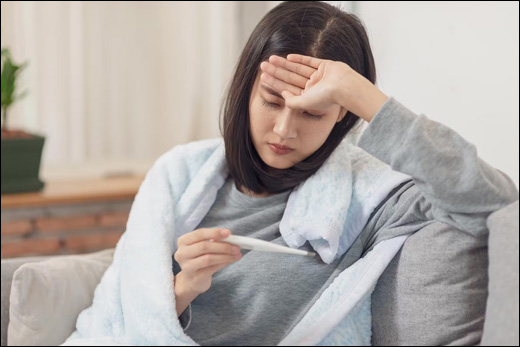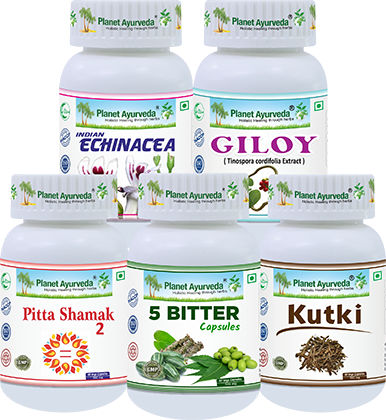Understanding Fever (Jwara) from an Ayurvedic Pointview – The Body’s Natural Defense Mechanism
Abstract
Fever is a temporary elevation of body temperature resulting from an underlying infection, inflammation, or immune response. It is medically termed as Pyrexia. In modern medicine, it is viewed as a protective mechanism initiated by the hypothalamus in response to pyrogens, helping the body combat pathogens. In Ayurveda, fever is described as Jwara, a condition that affects both body and mind, arising from an imbalance of doshas, primarily Pitta. Acharya Charaka describes Jwara as the “King of all diseases (Rogadhipati)”, because it influences the entire system by disturbing the balance of Doshas and weakening Agni (digestive fire). Among the three doshas, Pitta plays a central role due to its control over heat and metabolism. Ayurvedic management focuses on balancing Pitta dosha, eliminating Ama (toxins), and restoring Agni, using herbs, diet, and detox therapies to achieve natural healing.

Introduction
Chronic fever, also known as long-term or persistent fever, refers to a condition in which the body temperature remains elevated for an extended period, typically more than three weeks, without an easily identifiable cause. Unlike acute fever, which develops suddenly and resolves within a few days, chronic fever is often a manifestation of an underlying systemic disorder such as infection, autoimmune disease, or metabolic imbalance. Chronic fever results from a prolonged inflammatory response within the body, triggered by infectious agents (like tuberculosis or typhoid), autoimmune conditions (such as rheumatoid arthritis or lupus). The sustained rise in body temperature occurs due to the persistent release of pyrogens, which act on the hypothalamic thermoregulatory centre to elevate the body’s temperature set point. In Ayurveda, fever is considered one of the most significant diseases, as it disturbs the normal functioning of Agni (digestive fire) and spreads throughout the body via vitiated doshas and Ama (toxins). The management of fever in Ayurveda focuses on balancing Pitta, restoring digestive strength, detoxifying the system, and enhancing immunity through herbal formulations and natural therapies.
Fever – A Natural Defence Mechanism
When harmful microorganisms invade the body, the immune system responds by releasing pyrogens that raise body temperature, creating fever as a natural defence. This elevated heat slows pathogen growth and enhances the activity of immune cells to eliminate infection. However, if the fever becomes continuously persistent, it should be properly managed to prevent complications. From an Ayurvedic view, prolonged fever often indicates aggravated Pitta dosha, which must be balanced through Ayurvedic herbs and a supportive diet. Thus, fever is both a protective mechanism and a sign to restore balance within the body.
Causes Of Fever
1. Infectious Causes
- Viral infections: Common cold, flu, COVID-19.
- Bacterial infections: Strep throat, pneumonia, urinary tract infections.
- Fungal infections: Certain fungal diseases may produce fever.
2. Non-Infectious Causes
- Inflammatory conditions: Rheumatoid arthritis, ulcerative colitis.
- Medications: Some antibiotics and anti-epileptic drugs can induce fever.
- Heat-related illnesses: Heat exhaustion or heatstroke.
- Cancers: Certain tumours can cause persistent fever.
- Other causes: Allergic reactions, blood clots, or teething in infants.
Symptoms Of Fever
Fever is accompanied by various observable changes that reflect the body’s defence mechanism. The common symptoms of Fever are discussed below:
- Headache and body aches
- Fatigue and weakness
- Irritability, especially in children
- Loss of appetite and thirst or dryness from dehydration
- Sleep disturbances or vivid “fever dreams”
Signs Of Fever
Various systemic and physical signs help in identifying the presence and severity of fever. Here are some common signs of fever:
- Elevated body temperature: Above 100.4°F (38°C).
- Flushed or warm skin: Redness or heat to the touch.
- Sweating: Occurs as the body cools down.
- Shivering or chills: Body’s mechanism to raise temperature.
- Increased heart rate: Due to higher metabolic activity.
- Other signs: Rash, fever blisters, or dehydration (reduced urination).
Diagnosis Of Fever
The diagnosis of fever depends on the type of fever (Typhoid, Malaria, etc.). Here are some common diagnostic criteria for the diagnosis of general fever:
- Oral temperature above 100.4°F (38°C) indicates fever.
- Fever duration is classified as acute (<7 days), subacute (7–14 days), or chronic (>14 days).
- Symptoms like chills, sweating, fatigue, and body aches support the diagnosis.
- Lab tests (CBC, CRP, ESR) help identify underlying causes.
- Blood and urine cultures are used if infection is suspected.
Ayurvedic Overview
According to Charaka Samhita, Jwara (fever) is regarded as the “king of all diseases” (Roga-Raja) because it afflicts all living beings from birth to death, affecting both the body and mind. Charaka describes its pathogenesis (Samprapti) as a disturbance of the Tridoshas (Vata, Pitta, and Kapha), which disrupts the balance of Agni (digestive fire) and leads to the formation of Ama (toxins). These vitiated doshas and Ama (Toxins) circulate through the Rasa (channels for transportation of nutritive fluids) and Sweda (channels of transportation of sweat) srotas (channels), causing obstruction and displacing heat from the digestive region to the entire body, resulting in elevated temperature and systemic distress.
ज्वरस्तु खलु महेश्वरकोपप्रभवः, सर्वप्राणभृतां प्राणहरो, देहेन्द्रियमनस्तापकरः, प्रज्ञाबलवर्णहर्षोत्साहह्रासकरः, श्रमक्लममोहाहारोपरोधसञ्जननः; ज्वरयति शरीराणीति ज्वरः, नान्ये व्याधयस्तथा दारुणा बहूपद्रवा दुश्चिकित्स्याश्च यथाऽयम्| स सर्वरोगाधिपतिः, नानातिर्यग्योनिषु च बहुविधैः शब्दैरभिधीयते|सर्वे प्राणभृतः सज्वरा एव जायन्ते सज्वरा एव म्रियन्ते च; स महामोहः, तेनाभिभूताः प्राग्दैहिकं देहिनः कर्म किञ्चिदपि न स्मरन्ति, सर्वप्राणभृतां च ज्वर एवान्ते प्राणानादत्ते||
(Charak Nidana sthana 1/35)
“Jwara (Fever), arising from the wrath of Maheshwara (Lord Shiva), is the king of diseases. It affects the body (Sharira), mind (Manas), and senses (Indriyas), causing grief (Santapa), weakness (Daurbalya), fatigue (Shrama), confusion (Bhrama), loss of intellect (Buddhi), and appetite (Agnimandya). Fever can be life-threatening, causes delirium (Moha), and ultimately ends life, making it a complex and frightful disease. All living beings are born and die with fever, highlighting its universal and powerful nature.”
Types Of Jwara (Fever)
द्विविधो विधिभेदेन ज्वरः शारीरमानसः|
पुनश्च द्विविधो दृष्टः सौम्यश्चाग्नेय एव वा||
अन्तर्वेगो बहिर्वेगो द्विविधः पुनरुच्यते|
प्राकृतो वैकृतश्चैव साध्यश्चासाध्य एव च|
पुनः पञ्चविधो दृष्टो दोषकालबलाबलात्|
सन्ततः सततोऽन्येद्युस्तृतीयकचतुर्थकौ||
पुनराश्रयभेदेन धातूनां सप्तधा मतः|
भिन्नः कारणभेदेन पुनरष्टविधो ज्वरः||
(Charak Chikitsa sthana 3/32-35)
Jwara (fever) is categorised in multiple ways in Ayurveda:
- Based on involvement of the body and mind: Sharira (physical) and Manasa (mental)
- According to the dominant qualities: Saumya (cold-dominant) and Agneya (heat-dominant)
- By the direction of disease movement: Antarvega (internal) and Bahirvega (external)
- By seasonal occurrence: Prakrita (seasonal/expected) and Vaikrita (unseasonal/abnormal)
- Based on prognosis: Sadhya (curable) and Asadhya (incurable)
Additionally, fever is classified into five forms of intermittent patterns, depending on dosha strength and timing:
- Santata Jvara – Fever that persists continuously without any interval of relief.
- Satata Jvara – Fever that occurs repeatedly with mild intervals but does not fully subside.
- Anyedyushka Jvara – Fever that appears on alternate days with a clear fever-free day in between.
- Tritiyaka Jvara – Fever that returns every third day (typically linked to malaria-type fevers).
- Chaturthaka Jvara – Fever that recurs every fourth day with longer afebrile intervals.
Jwara is also divided into seven types according to its site of manifestation within the seven dhatus (body tissues). Furthermore, it is classified into eight types depending on the predominant dosha-related causation.
Correlation of Some Common Ayurvedic Fevers with Modern Fevers
|
Ayurvedic Jwara (Fever) |
Modern Fever |
|
Vishama Jwara |
Malaria |
|
Manthar Jwara |
Typhoid |
|
Dandaka Jwara |
Dengue |
|
Shawasnaka Jwara |
Pneumonia |
|
Shilashamika Jwara |
Influenza |
|
Geantika Jwara |
Plague |
|
Sandhika Jwara |
Rheumatic Fever |
|
Akshepaka Jwara |
Cerebrospinal Fever |
|
Karnamulika Jwara |
Mumps |
|
Romantika |
Measles |
|
Masurika |
Small Pox |
|
Laghu Masurika |
Chicken pox |
|
Mushika Dansh Jwara |
Rat Bite Fever |
Premonitory Symptoms of Jwara (Fever)
आलस्यं नयने सास्रे जृम्भणं गौरवं क्रमः|
ज्वलनातपवाय्वम्बुभक्तिद्वेषावनिश्चितौ||२८||
अविपाकास्यवैरस्ये हानिश्च बलवर्णयोः|
शीलवैकृतमल्पं च ज्वरलक्षणमग्रजम्||२९||
(Charak Chikitsa sthana 3/28-29)
Laziness, excessive tearing, frequent yawning, a feeling of heaviness, mental tiredness, indecisiveness, and an inability to tolerate heat, sunlight, wind, or water — along with indigestion, loss of appetite, reduced strength and complexion, and subtle behavioural changes — are considered the early warning signs of Jwara (fever).
Symptoms Of Jwara (Fever)
ज्वरप्रत्यात्मिकं लिङ्गं सन्तापो देहमानसः|
ज्वरेणाविशता भूतं न हि किञ्चिन्न तप्यते||
(Charak Chikitsa sthana 3/31)
The hallmark features of Jwara (Fever) are elevated body temperature and a general feeling of discomfort in both body (Sharira) and mind (Manas). It affects the entire body, including the sensory organs (Indriyas), in all living beings.
Precautions At The Initial Stage Of Jwara (Fever)
नवज्वरे दिवास्वप्नस्नानाभ्यङ्गान्नमैथुनम्||१३८||
क्रोधप्रवातव्यायामान् कषायांश्च विवर्जयेत्|
(Charak Chikitsa sthana 3/138-139)
A patient in the stage of Nava Jwara (initial stage of fever) should avoid daytime sleep, bathing, massage, heavy or hard-to-digest foods, sexual activity, anger, direct exposure to wind, vigorous exercise, and astringent (Kashaya) foods.
Management Principle Of Jwara (Fever)
लङ्घनं स्वेदनं कालो यवाग्वस्तिक्तको रसः||१४२||
पाचनान्यविपक्वानां दोषाणां तरुणे ज्वरे|१४३|
(Charak Chikitsa sthana 3/142)
In Taruna Jwara (the initial stage of fever), treatments include Langhana (fasting), Swedana (fomentation), Kala (an eight-day observation period), Yavagu (medicated gruels), Tikta Rasa drugs (bitter-tasting medicines), and all digestive enhancers to correct Avipakva Dosha (undigested/accumulated doshas).
Benefits Of Langhana (Fasting) In Jwara (Fever)
लङ्घनेन क्षयं नीते दोषे सन्धुक्षितेऽनले||
विज्वरत्वं लघुत्वं च क्षुच्चैवास्योपजायते |
प्राणाविरोधिना चैनं लङ्घनेनोपपादयेत्||
बलाधिष्ठानमारोग्यं यदर्थोऽयं क्रियाक्रमः|
(Charak Chikitsa sthana 3/140-142)
Langhana (Fasting) helps pacify the aggravated doshas and enhances digestive fire (agni), which in turn reduces fever, lightens the body, and restores appetite. However, it should be practised carefully without compromising the person’s overall strength and vitality. The ultimate goal of these measures is to revive health, which relies on maintaining physical, mental, and spiritual well-being.
Role Of Shadanga Paniya In Jwara (Fever)
मुस्तपर्पटकोशीरचन्दनोदीच्यनागरैः||
शृतशीतं जलं दद्यात् पिपासाज्वरशान्तये|
(Charak Chikitsa sthana 3/145)
To relieve thirst and fever, the patient should be given boiled water that has been cooled after being infused with herbs such as Musta (Cyperus rotundus), Parpataka (Fumaria indica), Ushira (Vetiveria zizanioides), Chandana (Santalum album), Udichya (Aquilaria agallocha), and Nagara (Zingiber officinale).
Panchkarma In Jwara (Fever)
Panchakarma is the five-fold Ayurvedic detoxification and purification therapy aimed at eliminating vitiated Doshas and restoring body balance. Here are the Panchkarma therapies that are used in the management of Jwara (Fever):
- Virechana (Therapeutic Purgation): Removes excess Pitta and toxins, especially in Pitta-type fevers.
- Vamana (Therapeutic Emesis): Eliminates Kapha accumulation, useful in Kapha-type fevers.
- Swedana (Fomentation/Sudation): Induces sweating to reduce heat, toxins, and body stiffness.
- Raktamokshana (Bloodletting/Blood Purification): Purifies blood in Rakta-dushita Jwara, reducing inflammation and high fever.
- Basti (Medicated Enemas – Anuvasana/Niruha): Balances Vata and aids in detoxification, especially in chronic fevers.
Ayurvedic Management Of Jwara (Fever)
In Ayurveda, Jwara (Fever) is managed with herbs that pacify aggravated doshas, mainly Pitta dosha, detoxify the body, and support immunity. Guduchi (Tinospora cordifolia) is a primary herb that strengthens immunity and reduces Pitta, while Amalaki (Emblica officinalis) cools the body and supports digestion. Bitter herbs like Chirayata (Swertia chirayita) and Kutki (Picrorhiza kurroa) help in detoxification and lowering elevated body temperature. Tulsi (Ocimum sanctum) balances Vata and Pitta, supporting respiratory health, and Brahmi (Bacopa monnieri) calms the nervous system, reducing restlessness during fever.
Herbal Remedies For Jwara (Fever) By Planet Ayurveda
Planet Ayurveda is a trusted organisation dedicated to providing 100% pure, natural, and authentic Ayurvedic products. With a strong focus on quality, all formulations are made from herbs sourced from the best organic farms, processed under strict Ayurvedic principles. Planet Ayurveda aims to promote holistic health and wellness by combining classical Ayurvedic wisdom with modern quality standards. Their products are free from chemicals, preservatives, and artificial additives, making them safe for long-term use. With a mission to support preventive and curative healthcare, Planet Ayurveda offers a wide range of herbal remedies for various health conditions, empowering individuals to lead healthier and balanced lives. Here in this article, we will discuss the basic Ayurvedic formulation for Fever. Let’s start!
- 5 Bitters Capsules
- Cap. Pitta Shamak 2
- Kutki Capsules
- Indian Echinacea Capsules
- Giloy Capsules
Dosage
- 5 Bitter Capsules : 1 capsule twice daily after a meal with 50 ml of fresh coriander leaf juice.
- Cap. Pitta Shamak 2 : 1 capsule twice daily after a meal with 50 ml of fresh coriander leaf juice.
- Kutki Capsules : 1 capsule twice daily after a meal with 50 ml of fresh coriander leaf juice.
- Indian Echinacea Capsules : 1 capsule twice daily after a meal with 50 ml of fresh coriander leaf juice.
- Giloy Capsules : 1 capsule twice daily after a meal with 50 ml of fresh coriander leaf juice.
Product Description
1. 5 Bitter Capsules
5 Bitter Capsules from Planet Ayurveda contain Patol (Trichosanthes dioica), Vasa (Adhatoda vasica), Neem (Azadirachta indica), Pitpapada (Fumaria officinalis), and Giloy (Tinospora cordifolia / malabarica). These herbs are bitter in taste, which is highly effective in pacifying Pitta dosha during fever. Patol contains trichosanthin and flavonoids, which help reduce body heat and inflammation. Vasa has vasicine and vasicinone, providing antipyretic and respiratory support. Neem is rich in nimbin, nimbidin, and quercetin, aiding blood purification and Pitta balance. Pitpapada contains Fumaramine and other alkaloids, helping reduce heat. Giloy provides tinosporaside, berberine, and other alkaloids, which enhance immunity, detoxify blood, and reduce fever naturally. Together, these herbs work synergistically to lower body temperature, restore Agni (digestive fire), and maintain overall dosha balance, making 5 Bitters Capsules an effective Ayurvedic formulation for fever management.
2. Cap. Pitta Shamak 2
Cap. Pitta Shamak 2 by Planet Ayurveda are formulated with Pittapapda (Fumaria indica) and Patol (Trichosanthes dioica), both known for their cooling and bitter properties, which make them highly effective in reducing heat and inflammation during fever. These herbs contain Fumaramine, tricosanthin, and other alkaloids, which help detoxify the blood, calm irritability, and pacify aggravated Pitta. This formulation supports body temperature regulation and helps maintain dosha equilibrium, making it suitable for managing both acute and chronic fevers naturally.
3. Kutki Capsules
Kutki Capsules from Planet Ayurveda contain Picrorhiza kurroa, a potent bitter herb used for Pitta-related fevers and liver detoxification. Its active constituents — picroside I, kutkoside, and iridoid glycosides — help reduce body heat and enhance digestion. This formulation promotes the elimination of toxins (Ama) and restores Pitta dosha balance, making it highly effective in managing high-grade fevers naturally.
4. Indian Echinacea Capsules
Indian Echinacea (Kalmegh) Capsules by Planet Ayurveda are known for their antipyretic, anti-inflammatory, and immune-modulating properties. The key chemical andrographolide helps lower body temperature and combat infections. Its bitter and pungent taste pacifies Pitta dosha, reduces inflammation, and strengthens the body’s natural defence. This formulation also aids detoxification, preventing fever complications.
5. Giloy Capsules
Giloy Capsules from Planet Ayurveda contain Tinospora cordifolia, a classic Rasayana herb that enhances immunity and detoxifies the blood. Its active constituents, like tinosporaside, berberine, and alkaloids, provide antipyretic, anti-inflammatory, and antioxidant effects. Giloy works in fever by boosting immune defences through the activation of macrophages and B-cells, helping the body fight infections more effectively. It also reduces inflammation and fever by lowering pro-inflammatory cytokines and inhibiting pathways responsible for heat and swelling. Additionally, its natural antimicrobial compounds assist in decreasing pathogen load, thereby reducing the cause of fever.
All these Ayurvedic herbs are also effective in case of Chronic fever (Jeerna Jwara). Now, we will discuss some other Ayurvedic formulations of Planet Ayurveda for fever associated with other conditions, along with the above Ayurvedic medicines:
For Heat-Related Lyme Disease Add
Amalaki Rasayan Capsules
Amalaki Rasayan by Planet Ayurveda is a classical Ayurvedic formulation made from Amla (Emblica officinalis), renowned for its cooling, bitter, and astringent properties. It is highly effective in managing fevers associated with infections, including Lyme disease, by pacifying aggravated Pitta dosha and supporting the body’s natural detoxification. The active compounds, such as ascorbic acid (Vitamin C), tannins, flavonoids, and gallic acid, provide antioxidant, immunomodulatory, and anti-inflammatory effects, helping reduce body heat, strengthen immunity, and support recovery. By enhancing Agni (digestive fire) and promoting Rasayana (rejuvenation) effects, Amalaki Rasayan helps restore overall vitality while naturally combating Pitta-related fever, inflammation, and oxidative stress.
Dosage– 2 capsules twice daily after a meal with 50 ml of fresh coriander leaf juice.
Fever Related To Rheumatism Add
Rumogin 5 Capsules
Rumogin 5 Capsules by Planet Ayurveda are enriched with powerful herbs like Haridra (Curcuma longa), Sonth (Zingiber officinale), Shallaki (Boswellia serrata), Maricha (Piper nigrum), and Pippali (Piper longum). This unique combination targets fever associated with rheumatism, where Vata and Kapha imbalance and Ama (toxins) are involved. These ingredients contain curcumin, boswellic acids, gingerols, and piperine, which possess strong anti-inflammatory, analgesic, and detoxifying properties. Together, they help reduce joint pain, stiffness, swelling, and support digestion to eliminate Ama. By restoring Agni and balancing Vata-Kapha, Rumogin 5 aids in lowering systemic inflammation and rheumatic fever, promoting comfortable movement and overall well-being.
Dosage– 2 capsules twice daily after a meal with 50 ml of fresh coriander leaf juice.
To buy Herbal Remedies, please visit store.planetayurveda.com.
Conclusion
Fever represents the body’s natural defence response, signalling an underlying imbalance that requires attention. Ayurveda identifies this condition largely with Pitta disturbance and accumulation of Ama, guiding treatment toward detoxification and restoring digestive fire. Herbal medicines, dietary regulations, and rest help the body regain harmony without suppressing its healing intelligence. Supportive therapies focus on cooling, light nourishment, and preventing complications. With early and proper management, Ayurveda aims not only to reduce fever but also to strengthen overall immunity and resilience.




